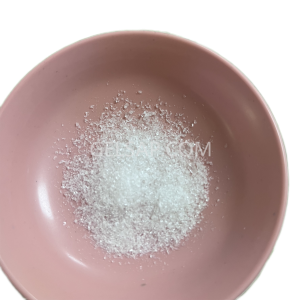Sodium poliakrilat, a polimer superabsorbendikenal luas karena kemampuannya yang luar biasa dalam menyerap dan menahan air dalam jumlah besar relatif terhadap massanya sendiri. Zat yang menarik ini digunakan dalam berbagai aplikasi, mulai dari popok bayi hingga produk pertanian. Mari kita pelajari ilmu di balik natrium poliakrilat, cara kerjanya, cara pembuatannya, dan umur panjangnya.

Bagaimana Sodium Poliakrilat Menyerap Air?
Rahasia kehebatan natrium poliakrilat dalam menyerap air terletak pada struktur molekulnya. Sodium poliakrilat adalah polimer, yang berarti terdiri dari rantai panjang unit yang berulang. Unit-unit ini, yang berasal dari asam akrilat, dihubungkan melalui proses yang disebut polimerisasi. Rantai polimer yang dihasilkan memiliki banyak ion natrium yang melekat padanya.
Ketika natrium poliakrilat bersentuhan dengan air, molekul air ditarik ke dalam jaringan polimer melalui osmosis. Ion natrium memisahkan diri dari rantai polimer, menciptakan situs bermuatan negatif di sepanjang tulang punggung polimer. Situs bermuatan negatif ini menarik molekul air, yang bersifat polar dan memiliki sedikit muatan positif. Daya tarik ini menyebabkan polimer membengkak saat menyerap air, berubah dari bubuk atau butiran kering menjadi zat seperti gel.
Bagaimana Cara Kerja Sodium Polyacrylate?
Mekanisme kerja natrium poliakrilat dapat dipecah menjadi beberapa langkah utama:
- Kontak Awal: Ketika natrium poliakrilat kering bertemu dengan air, molekul air tertarik ke ion natrium dan bagian hidrofilik (penarik air) dari rantai polimer.
- Penyerapan dan Pembengkakan: Saat molekul air menembus struktur polimer, molekul air tertarik ke situs bermuatan negatif pada tulang punggung polimer. Rantai polimer mulai membengkak, menciptakan konsistensi seperti gel saat menyerap air.
- Kondisi Ekuilibrium: Polimer terus menyerap air hingga tercapai keseimbangan. Ini adalah saat tekanan osmotik (gaya yang mendorong air ke dalam polimer) diimbangi oleh gaya elastis dari jaringan polimer yang membengkak, yang mencoba kembali ke keadaan semula.
Bagaimana Sodium Polyacrylate Dibuat?
Produksi natrium poliakrilat melibatkan beberapa langkah:
- Polimerisasi: Prosesnya dimulai dengan polimerisasi asam akrilat, yang melibatkan penggabungan monomer (unit tunggal) asam akrilat ke dalam rantai polimer yang panjang. Hal ini dapat dicapai melalui polimerisasi radikal bebas.
- Netralisasi: Polimer asam akrilat kemudian dinetralkan dengan natrium hidroksida untuk mengubahnya menjadi natrium poliakrilat. Langkah ini memperkenalkan ion natrium yang sangat penting untuk sifat penyerap air polimer.
- Pengeringan dan Penggilingan: Gel natrium poliakrilat yang dihasilkan dikeringkan untuk menghilangkan kelebihan air dan kemudian digiling menjadi bentuk bubuk atau butiran, sehingga lebih mudah ditangani dan digunakan dalam berbagai aplikasi.
Berapa Lama Sodium Polyacrylate Bertahan?
Umur panjang natrium poliakrilat sangat tergantung pada aplikasi spesifik dan kondisi lingkungan. Dalam lingkungan yang kering dan terkendali, natrium poliakrilat dapat bertahan tanpa batas waktu, mempertahankan kemampuannya menyerap air. Namun, setelah menyerap air dan membentuk gel, stabilitasnya dapat bervariasi:
- Dalam Popok dan Produk Kebersihan: Dalam aplikasi ini, natrium poliakrilat dirancang untuk sekali pakai. Setelah menyerap air seni atau cairan lain, ia akan dibuang setelah sekali pakai.
- Dalam Aplikasi Pertanian: Ketika digunakan di tanah untuk mempertahankan kelembapan, natrium poliakrilat dapat bertahan selama beberapa bulan hingga beberapa tahun. Umur panjangnya dipengaruhi oleh faktor-faktor seperti komposisi tanah, suhu, dan aktivitas mikroba.
- Degradasi Lingkungan: Seiring waktu, natrium poliakrilat dapat terdegradasi karena paparan sinar ultraviolet, panas, dan aktivitas mikroba. Proses degradasi ini dapat memakan waktu beberapa bulan hingga bertahun-tahun, tergantung pada kondisi lingkungan.
Kesimpulan
Sodium poliakrilat adalah bahan yang luar biasa dengan sifat menyerap air yang unik yang membuatnya sangat berharga dalam berbagai industri. Kemampuannya untuk menyerap dan menahan air disebabkan oleh struktur polimer dan keberadaan ion natrium, yang menarik dan menahan molekul air. Proses produksinya melibatkan polimerisasi dan netralisasi asam akrilat, diikuti dengan pengeringan dan penggilingan. Meskipun natrium poliakrilat dapat bertahan tanpa batas waktu dalam keadaan kering, umur panjangnya dalam aplikasi praktis bervariasi berdasarkan kondisi lingkungan dan penggunaan.
Baik dalam popok bayi, produk pertanian, atau aplikasi lainnya, natrium poliakrilat terus menunjukkan potensi luar biasa dari ilmu polimer dalam memecahkan tantangan sehari-hari.

